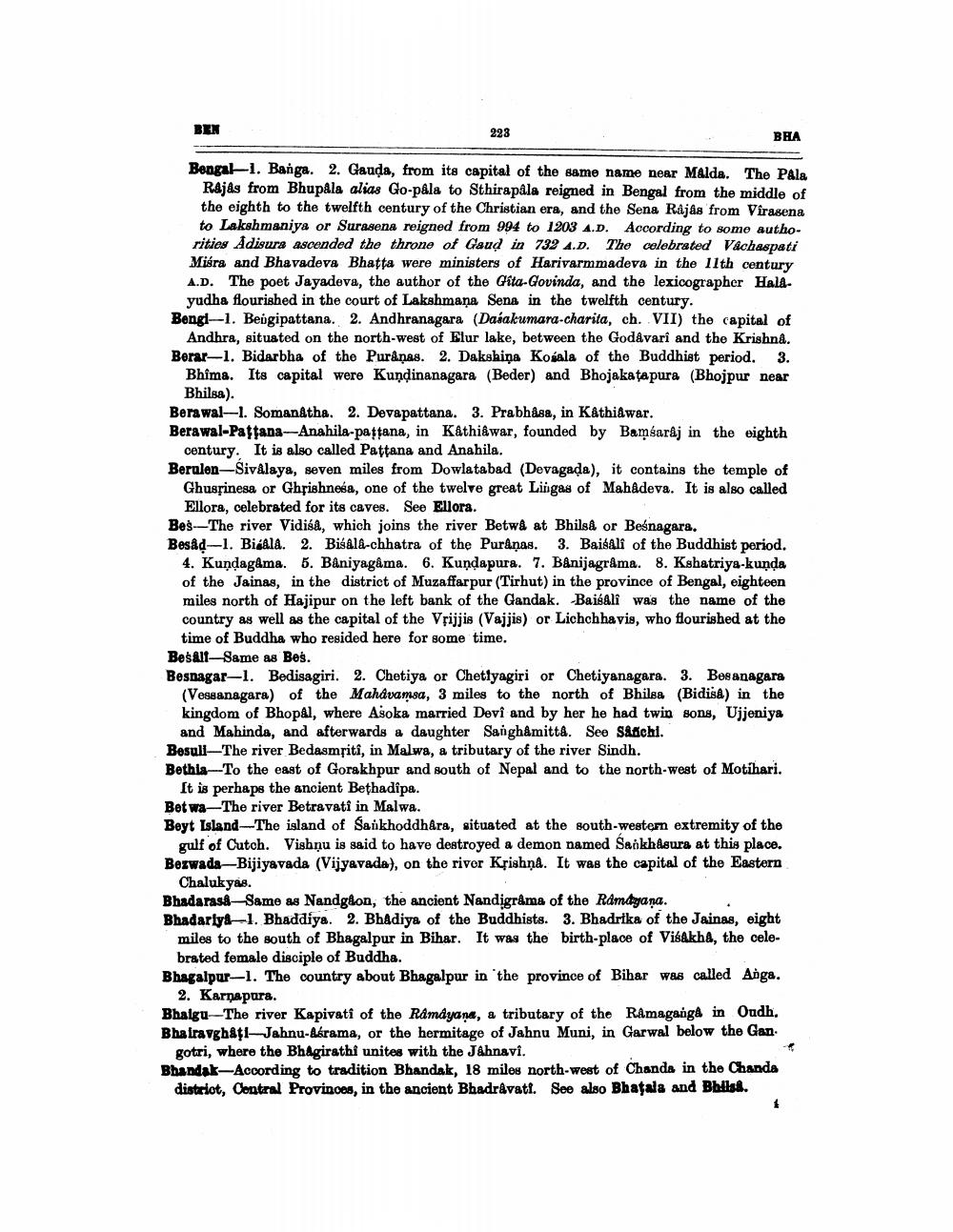________________
BEN
223
BHA
Bengal1. Banga. 2. Gauda, from its capital of the same name near Malda. The Pala
Rajas from Bhup&la alias Go-påla to Sthirapala reigned in Bengal from the middle of the eighth to the twelfth century of the Christian era, and the Sena Rajâs from Vîrasena to Lakshmaniya or Surasena reigned from 994 to 1203 A.D. According to some authorities Adisura ascended the throne of Gaud in 732 A.D. The colebrated Vachaspati Misra and Bhavadeva Bhatta were ministers of Harivarmmadeva in the 19th century A.D. The poet Jayadeva, the author of the Cita-Govinda, and the lexicographer Hald
yudha flourished in the court of Lakshmana Sena in the twelfth century. Bengt-1. Bengipattana. 2. Andhranagara (Dasakumara charita, ch. VII) the capital of
Andhra, situated on the north-west of Elur lake, between the Godavari and the Krishna. Berar-1. Bidarbha of the Puranas. 2. Dakshina Kosala of the Buddhist period. 3.
Bhîma. Its capital were Kundinanagara (Beder) and Bhojakatapura (Bhojpur near
Bhilsa). Berawal-1. Somanatha. 2. Devapattana. 3. Prabhasa, in Káthidwar. Berawal-Pattana--Anahila-pattana, in Kathiawar, founded by Bamgaraj in the eighth
century. It is also called Pattana and Anahila. Berulon-SivAlaya, seven miles from Dowlatabad (Devagada), it contains the temple of
Ghusrinesa or Ghrishnesa, one of the twelve great Lingas of Mahadeva. It is also called
Ellora, celebrated for its caves. See Ellora. Bes---The river Vidisa, which joins the river Betwa at Bhilsa or Beśnagara. Besad--1. Bisala. 2. BiśAla-chhatra of the Puranas. 3. Baibali of the Buddhist period.
4. Kundag&ma. 5. Baniyagama. 6. Kundapura. 7. Banijagrama. 8. Kshatriya-kunda of the Jainas, in the district of Muzaffarpur (Tirhut) in the province of Bengal, eighteen miles north of Hajipur on the left bank of the Gandak. Baibali was the name of the country as well as the capital of the Vțijjis (Vajjis) or Lichchhavis, who flourished at the
time of Buddha who resided here for some time. Besalt-Same as Bes. Besnagar–1. Bedisagiri. 2. Chetiya or Chetiyagiri or Chetiyanagara. 3. Besanagara
(Veseanagara) of the Mahavamsa, 3 miles to the north of Bhilsa (Bidisa) in the kingdom of Bhopal, where Asoka married Devi and by her he had twin sons, Ujjeniya and Mahinda, and afterwards a daughter Sanghåmitta. See Såfichi. Besull-The river Bedasmriti, in Malwa, a tributary of the river Sindh. Bethla-To the east of Gorakhpur and south of Nepal and to the north-west of Motihari.
It is perhaps the ancient Bethadipa. Betwa-The river Betravati in Malwa. Beyt Island The island of Sankhoddhåra, situated at the south-western extremity of the
gulf of Cutch. Vishnu is said to have destroyed a demon named Sankh Asura at this place. Bezwada--Bijiyavada (Vijyavada), on the river Krishna. It was the capital of the Eastern
Chalukyas. Bhadarasa Same as Nandgaon, the ancient Nandigräma of the Ramayana. Bhadarly - 1. Bhaddiya. 2. Bhadiya of the Buddhists. 3. Bhadrtka of the Jainas, eight miles to the south of Bhagalpur in Bihar. It was the birth-place of Visakha, the cele
brated female disciple of Buddha. Bhagalpur-1. The country about Bhagalpur in the province of Bihar was called Anga.
2. Karnapura. Bhaigu--The river Kapivati of the Ramayana, a tributary of the Ramaganga in Oudh. Bhairavgbati-Jahnu-Abrama, or the hermitage of Jahnu Muni, in Garwal below the Gan.
gotri, where the Bhagirathi unites with the Jahnavi. Bhandak-According to tradition Bhandak, 18 miles north-west of Chanda in the Chanda
distriot, Control Provinces, in the ancient Bhadravati. See also Bhatala and Bhilsi.




